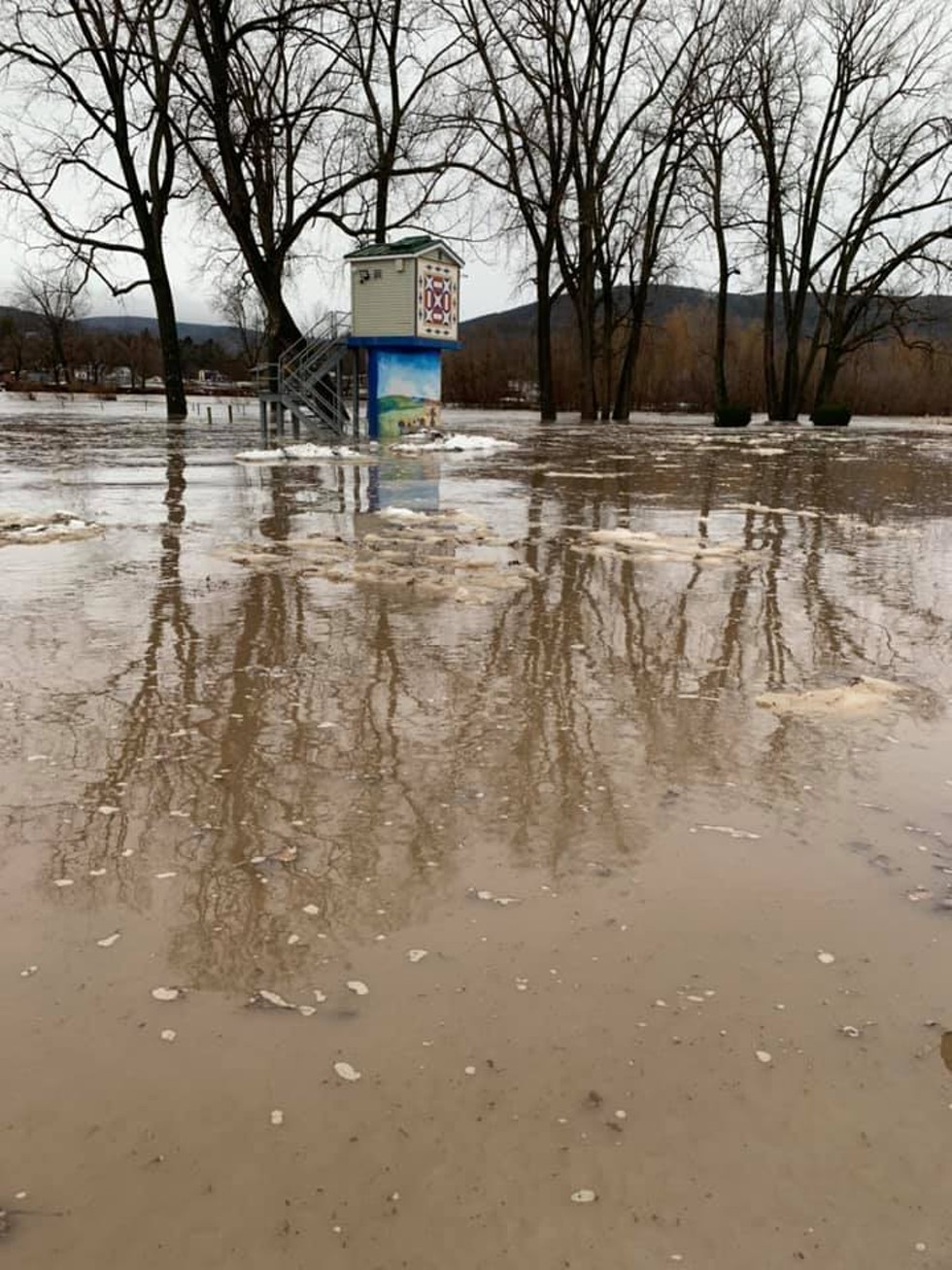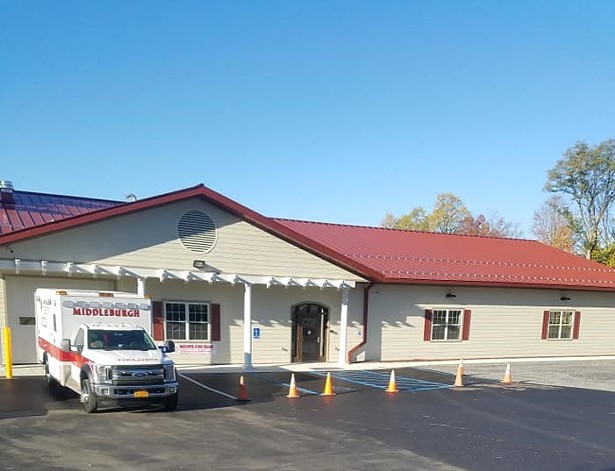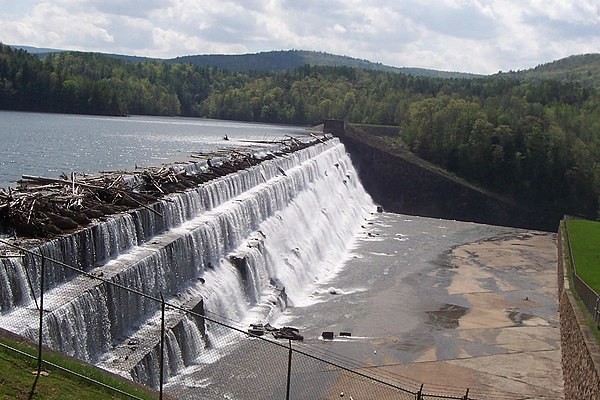Early on Christmas morning, I received a series of messages from a friend asking if my girlfriend and I were okay. Hours earlier in the town of Prattsville, roughly 20 miles down Schoharie Creek from where we live in the village of Middleburgh, flood sirens had been activated after heavy rainfall and snowmelt had caused rising flood waters.
The nearby fire department’s alarm jerked us fully awake, and I ran to the window to ensure we had not been caught unaware. Main Street remained dry, but rising water threatened to overspill the creek’s banks and flood our parking lot and roads leading out of town. We decided to evacuate to my girlfriend’s grandparents in the mountains, along with Christmas gifts and our two pet rabbits.
Living along Schoharie Creek is a calculated risk for residents in both Greene and Schoharie counties, as the creek is temperamental and can quickly transform into a raging river in the proper weather conditions.
Those conditions produced a near-miss on Christmas Day for inhabitants of creekside communities. A combination of unseasonably warm temperatures, nearly three feet of snowpack from the week prior, and a Christmas Eve storm that dumped heavy rainfall at the Schoharie’s headwaters in Elka Park caused the creek to spill its banks and threaten creekside residents with severe flooding for the first time since 2011, when Hurricane Irene devastated the area.
Irene caught local officials by surprise, and the eventual cost to municipalities and residents along the creek reached nearly $90 million in infrastructure projects alone. But it served as a lesson learned: the Christmas Day flood had been closely monitored in the preceding days by emergency officials, who took proactive steps to deter disaster.
This is how it happened.
4:30am. Christmas Day.
Hours after flood waters had forced a partial evacuation of Prattsville, Middleburgh Town Supervisor Wes Laraway received a phone call from Schoharie County Office of Emergency Services Director Mike Hartzel informing him of the latest numbers and what areas were threatened by flooding.
Roughly 10 miles down river, Blenheim Supervisor Don Airey had also been on the receiving end of early morning phone calls from Hartzel. Around 5am, Airey left his home in the mountains to survey the situation, where he found a “raging Schoharie and West Kill Creek convergence, and the park behind town hall totally underwater.”
Driving through the hamlet of North Blenheim, Airey found one evacuation route—Bear Ladder Road—already blocked by a vehicle owned by a Blenheim fireman. The road was “part of Schoharie Creek,” Airey remembers thinking. He continued about a quarter-mile outside town, where he found Route 30 two to three feet underwater and still rising. Airey stopped his vehicle in front of the flooded area to act as a roadblock.
From this vantage point, Airey could see where the old Blenheim Bridge once stood. One of the longest single-span covered bridges in the world, it was swept away by the ferocious floodwaters of Irene. Thanks to the efforts of Airey and the Blenheim Long-Term Recovery Committee, FEMA funding was secured to rebuild the Blenheim Bridge at the same spot as where the original had stood for over 150 years.
By this time, Hartzel had arrived on the opposite side of the flooded area on Route 30. He phoned Airey, who gave him troubling news: the New York Power Authority was reporting that 28,000 cubic feet per second of water was pouring through the gates at the Blenheim-Gilboa Pumped Storage Power Plant. Airey knew from personal experience that it was going to be a close call. The two men began discussing whether to utilize reverse 911, a public safety alert system used to communicate with local citizens during emergencies, and start evacuating residents.
7:30am. “Imminent danger.”
With the creek continuing to swell, Laraway received a phone call from Middleburgh Fire Chief Jerry Wayman: The department was planning to start evacuating residents, and Chief Wayman was wondering if the Middleburgh Community Center/Shelter could be opened and prepped to receive evacuees. Laraway and a fellow councilmember, Steve Hendrickson, had already discussed the possibility of opening the shelter, and they were ready to act.
No such community shelter existed in 2011, when dozens of Middleburgh residents sought refuge from Irene at Laraway’s farm. Many homes and businesses were damaged, some permanently so. The old NAPA store on Main Street was demolished. Residual clay dust from the creek bed will probably be found in basements for decades into the future. The new community shelter, just completed in 2020, will offer shelter from future storms for years to come.
Wayman then called Middleburgh Mayor Trish Bergan to notify her that the village Rotary Club’s “Lights in the Park” Christmas decorations at Timothy Murphy Park, located between Schoharie Creek and Route 30, were in danger of washing away. Bergan reached out to Rotarian Joan Wissert, who mobilized a group to save the merry decorations.


“I couldn’t get over how fast the water was rising,” Bergan says. “By the time we left, the water was over the road and heading toward the pavilion.” Rising waters had spread downstream from Blenheim, flooding the entire park and submerging the Middleburgh section of Route 30 within an hour or two.
11am. “Dodged a bullet.”
While monitoring the water levels in Blenheim, Airey saw that some residents were being trapped in town, but none he spoke to seemed interested in evacuating. “They are quite plucky in Blenheim regarding flooding, but I was ready to make the call,” Airey says.
The park behind town hall had been completely underwater earlier in the morning, but now Airey saw that a small island had emerged above the waterline, which meant that the Schoharie had finally reached its peak in Blenheim and was beginning to recede. Schoharie County Board of Supervisors Chairman Bill Federice, who is also the Conesville town supervisor, arrived in Blenheim to assist Airey if necessary.
The New York Power Authority was now reporting that 38,000 cubic feet per second of water were pouring through the power plant gates, but that number was holding steady, so Airey decided not to issue an evacuation order for Blenheim. Had the waters reached 40,000 CFS, he would have.
“We truly dodged a bullet,” Airey says. “In the end, a happy Christmas, if a bit harrowing. I was spent by 11.”
By early afternoon, a pattern had begun to emerge along the Schoharie: water would rise for a couple hours at a specific location, and then it would hold steady at crest for a couple of hours before gradually receding. It had happened two hours earlier in Blenheim, when Airey decided not to evacuate, and it was happening now in Middleburgh, where several roadways had become submerged.
Whereas most of the Schoharie Valley has ample low-lying areas and farmland across which rising flood waters can spread out harmlessly, the village of Middleburgh forms a bottleneck as the creek takes a sharp westerly turn on its northward course. According to Bergan, this bottleneck caused several streets and some low-lying areas behind Main Street businesses (including my apartment’s parking lot) to sustain minor flooding.
Fortunately, despite how close the waters came to reaching businesses and homes, the creek peaked by 1pm, sparing the village a repeat of either Irene’s devastation in 2011 or the onslaught of flash flooding that hit the community just two years later. Although Laraway had taken in a local family at his farm, he decided to close the shelter by noon when it became apparent that the flood would be a near miss.
Preparation Averts Disaster
As harrowing as Christmas Day could have been for residents, local officials, and first responders along Schoharie Creek, days of preparation leading up to the holiday weather event proved consequential to averting disaster. According to Schoharie County Fire Coordinator Matthew Brisley, the Office of Emergency Services (OES) had spent days preparing for potential flooding. They were first alerted to the threat on Sunday, December 20, by the National Weather Service in Albany.
“As the week progressed and more reliable forecasts were available, a clearer picture was in front of us,” Brisley explains.
After the alert from the National Weather Service, OES began monitoring a series of stream gauges situated along the creek, which give emergency officials current streamflow data and predicted flow levels throughout the valley. As the snowpack melted and the water level rose, Brisley began reaching out to fire chiefs throughout the Schoharie Valley to help them prepare for flooding.
“Throughout Christmas Day, the fire departments operated in accordance with their pre-plans for flooding, and worked hand in hand with their neighboring departments downstream to share real-time levels and crest times,” Brisley says. “This cooperation was critical to a successful response and timely notification to residents.”
Local officials hinted at another crucial factor: getting the New York City Department of Environmental Protection to start the siphons at the Gilboa Dam 36 hours in advance of the storm. According to Airey, approximately 8 to 10 feet of water was drawn down, creating a gap in the reservoir to create void space.
It is important to note that the Schoharie Creek isn’t just a creek, but that it flows through two man-made dams, which allows some control over the amount of water that flows in the creek. The effect of drawing down water from the reservoir is that the water didn’t go downstream to Schoharie Creek instead.
Activating the siphons allowed the dam to retain more water. “That may have made the difference,” Federice says.
“I truly believe the weeklong preparation by our office and all of the fire departments served the residents well,” Brisley says. “While unfortunate, previous floods and high water events give the emergency response community experience and benchmarks to either warn and notify or evacuate residents.”
Only Minor Damage Reported
No one was hurt in the Christmas Day downpour, and what could have been a catastrophic level of flooding was averted. In the end, no residents had to utilize the makeshift shelter in Middleburgh. But there was some damage.
The Schoharie County Department of Public Works and town highway departments identified $332,000 in repairs, mostly to roads. Conesville sustained $30,000 worth of damage due to road scouring, while Airey estimates initial road and park damages in Blenheim reaching $50,000. Mayor Bergan says that the Middleburgh Rotary Club was able to save the Christmas decorations from Timothy Murphy Park, but several village owned benches and picnic tables were washed away.
Federal help may not be soon forthcoming. According to Federice, there must be a minimum of $30 million of property damage for an emergency to qualify for federal emergency funding. More than six weeks after the flood, neither FEMA nor New York State Governor Andrew Cuomo’s office have issued any declarations about assisting localities with funding for repairs.
Nearly a decade after Irene, the Christmas Day flood was a warning for Schoharie Valley not to grow complacent about Schoharie Creek, which typically bursts its banks every 10 to 15 years. Hours after the creek’s waters had peaked in Middleburgh, my girlfriend and I left her grandparents’ house to survey the Valley. Route 30 remained underwater just outside of Middleburgh, but the nearby bridge that passes over the Schoharie had been reopened, and our home, while threatened, was safe.
















